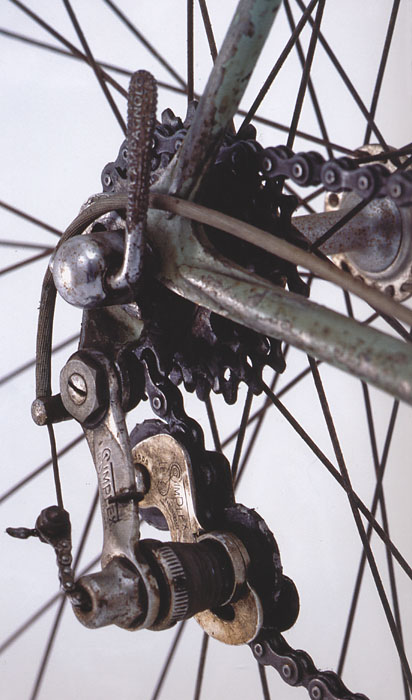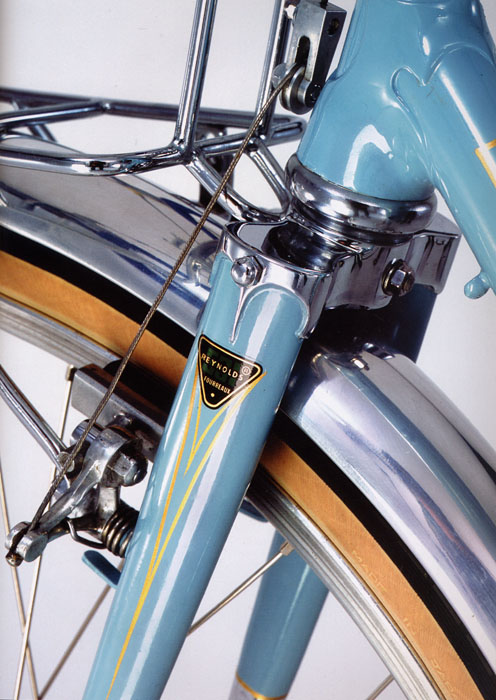book review
The Competition Bicycle
A Photographic History
The Competition Bicycle, A Photographic History, text by Jan Heine, photography by Jean-Pierre Praderes, published 2008 by Vintage Bicycle Press, 140 Lakeside Ave., Seattle WA 98122, USA. Hardcovers, 31x25 cm, 176 pages, profusely illustrated. 60 USD plus postage. Available online from:
http://www.vintagebicyclepress.com
|

"Each of the bikes in the following pages was hand-crafted by a master builder for the rigors of its specific event. As road conditions and race tactics changed over time, so did the bicycles that carried their riders to victory. The bicycles in this book chart the development of competition bicycles from racing highwheelers to modern bikes that fought for the most prestigious of all cycling awards, the hour record. Each bike highlights a chapter in the history of the competition bicycle. As far as possible, I have selected original machines with competition histories, which tell their stories through sweat-stained handlebar tape and well-worn saddles. These are the actual bikes on which great champions and other competitors surged toward the finish line." So writes Jan Heine in his Preface.
It is a tall order. How many actually-raced historical machines could one dig up today? I was skeptical at first. In order to fill a book, one would have to comb the museums of Europe and North America, and have incredibly good connections (per tu/du) with ex-champions (or their heirs). I am not usually one to judge a book by its cover, but given the above statement in the Preface, I had to wonder, is that bike on the cover not just any Eddy Mercx, but Eddy Merckx's Eddy Merckx?
The book starts in the 19th century with the first racing highwheelers. Perhaps surprisingly to some, late 19th century high wheelers already featured tubular frame construction, ball-bearing hubs, tied-and-soldered cross-spoked wheels, and weighed under 12 kgs.
From the 1920s there are two machines which took part in Tours de France, as well as six-day and motor-paced machines. Later bikes highlight Oscar Egg's derailleur, the use of aluminum for rims, handlebars, and other components. Below, a Caminargent from the 1930s with its unique octagonal aluminum tubing and bolted construction; a very early Stronglight cotterless crank is fitted:
|

In 1936, two Frenchmen set an hour record on a Delangle tandem; that very bike is featured, with original paint, original tires, and even an original customs seal (since the bike had travelled to Italy to take part in competition there).
RenÚ Vietto was a strong and popular rider, taking part in several Tours de France. Unfortunately, more due to unlucky circumstances than lack of ability, his race results did not match his potential. His bike as ridden in the 1947 Tour de France is featured. The Tour de France in 1949 was won by Coppi; his Bianchi is featured, unrestored--the patina of time sits gentley on it. His team mate cum rival Bartali finished second; Bartali's bike is also featured, as was. The description of their great rivalry, their double victory, and the different bikes they rode, makes exciting reading. Below, Fausto Coppi's Bianchi:
|


From the 1950s there is a simply gorgeous Rene Herse randonneur tandem, as raced to victory in the Paris-Brest-Paris by DeteÚ and BultÚ in apalling weather conditions. This has been restored in lovely French blue, with all the typical Herse touches (lamps, fenders, paniers, and special fitments everywhere you look).
|

From the mid 1960s there is a Cinelli Super Corsa with full Campag, the epitome of road racing for at least a decade. (Full marks for mentioning Spence Wolf's Cupertino Bike Shop--I knew that shop; Spence Wolf was one of two West Coast Hetchins importers.) Below: the bike to die for in 1965:
|

The book continues in this vein, for each decade one or more bikes are presented which embodied some technical development in componentry or frame design. In all, 34 bicycles are featured in chronological order, including that of the 1972 Women's World's Champion, one of Greg Lemond's bikes, Moser's Hour-Record Colnago (1984), and finally Tony Rominger's Hour-Record Colnago (1994).
The photography by Jean-Pierre Praderes is superb. Black-enamel frames with polished aluminum or chromed parts are hard to photograph properly. Either the blacks or the highlights tend to lack detail; not so here. I took a magnifying glass to each photo and was delighted to see minute detail everywhere. Knurling and file marks, grain in the wooden rims and frayed cloth on the tires, are all clearly visible. The book is a delight to the expert eye. Many of the chapters are supplimented by period-photographs, adverts, or posters.
There are two useful graphical indexes (though, awkwardly, one is at the front and the other is at the back) showing each bike featured, its date and rider (where known), geometry, and indicating which components are not original (where known).
The printing, binding, graphic design and layout (Christophe Courbou) are first rate. (However I detected a typo on page 15--that should read 1894 not 1994, but the context makes it clear enough.)
A comprehensive history of bicycle technology this is not; but then, it does not claim to be. A few significant moments are well-illustrated: for example, the 1947-49 Tours de France, which saw three different derailleur systems in use, or the introduction of indexing later on. In some cases, more is known about the rider or the race than about the bike, in others, the reverse. This is necessarily so in such a specialized field--extant bicycles of champions. So the history is a bit patchy, but the stories are always interestingly told. For a detailed history of gear changing see, for example, The Dancing Chain.
Heine's real passion is French hand-made bicycles, as showcased in his previous book, "The Golden Age of Handbuilt Bicycles". This book expands the horizon to embrace other marques. It is a worthy addition to velophilia. It is a passion worth showcasing and no one else has done it with such style! It is a real treat to see so many machines which were actually raced. Bearing in mind the subtitle, "A Photographic History", it certainly lives up to the author's Preface. This book reminds us, brilliantly, that the bicycle is not just a tin donkey; it is much grander than that, something iconic.
If you intend to own only one color-glossy book about racing bicycles, make it this one. If you already own a collection of color-glossy books about racing bicycles, it is incomplete without this one.
(PS: Yup, it's Eddy's Merckx.)
Review of The Golden Age of Handbuilt Bicycles by the same author.
|







